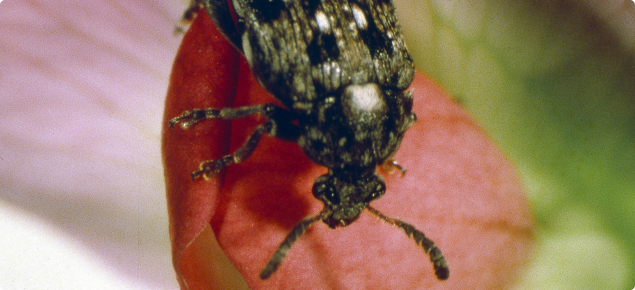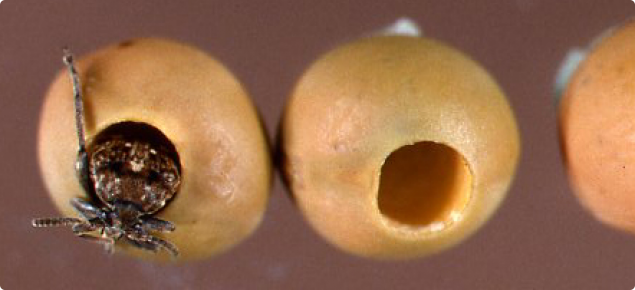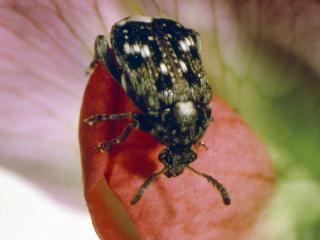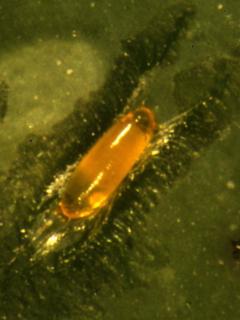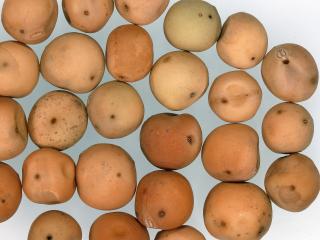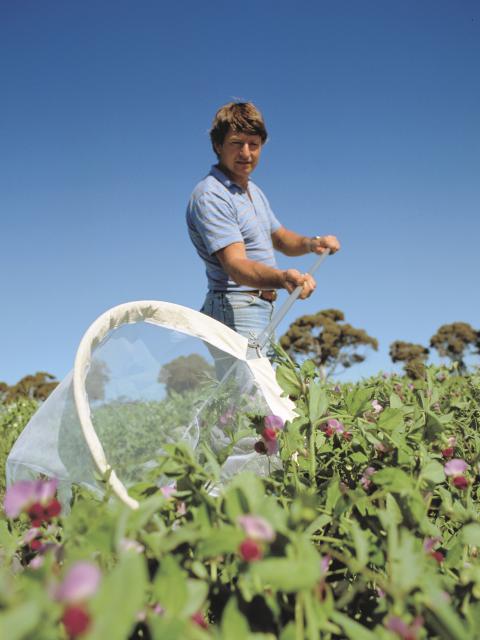Description
Adults:
- 5mm long
- brown with white, black and grey patches
- white tip of the abdomen is marked with two black, oval spots
- are not true weevils so lack the typical snout.
Eggs:
- bright yellow and cigar shaped
- about 1.5mm long
- attached individually to developing pods.
Larvae burrow directly into pods to feed on cotyledons and remain protected in the seed until the adult emerges. Once eggs are laid it is too late for field control.
Lifecycle
Adult beetles hibernate during summer, autumn and winter in sheltered positions, for example, under bark of trees, in cracks and crevices of fence posts.
When spring temperatures reach about 20°C, the beetles become active and are attracted to crops. Even though pea weevil can travel up to 5km, infestations usually occur from infested seed from the previous season.
The female beetles are sexually immature when they leave hibernation and first arrive in the pea crop.
They require a feed of pollen and further time for ovarian development to take place.
Approximately two weeks after arrival in the pea crop the females lay eggs on the developing pods.
Female beetle lay eggs, individually on the surface of pods.
Small larvae hatch from the eggs in about 6-13 days. The lavae bore through the wall of the pod and into the soft developing seed.
After about 40 days of feeding inside the pea seed the larvae prepares a 2-3mm exit hole by chewing partially through the seed coat.
The larvae then pupates and after about 14 days is ready to emerge as an adult beetle.
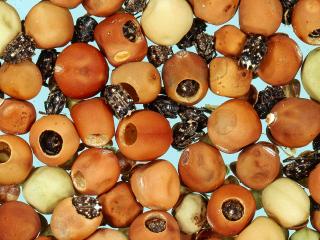
By this time the seed has generally been harvested and some beetles will emerge from the seeds to find suitable hibernation sites, others can remain concealed in grain for many months or when the grain is next sown.
The pea weevil will not reproduce in stored grain.
Damage
Pea weevil reduce yield by:
- consuming seed; as much as 30% of individual seed weight is lost from larval feeding
- feeding damage also increases the amount of seeds that split during sowing, harvesting and seed cleaning.
Many food consumption markets have a nil tolerance for live or dead adult pea weevil contamination or peas damaged by larval feeding.
The stock feed market has nil tolerance for live field pea weevil.
Pea weevil infested seed should be fumigated prior to sowing to prevent this pest spreading to new growing areas and to reduce the impact of this species on the pea crop later in the season.
Peas heavily damaged by pea weevil should not be sown without a germination test as the seed may not be viable or produce weak seedlings.
Monitoring
Where
- Pea weevil movement in early spring within a flowering crop is generally restricted to the crop’s edge, especially if adjacent to over-wintering sites such as trees and sheds.
When
- Monitor the crop edges every 3-4 days from the start of flowering. Monitor when average temperatures are above 20°C as this is when pea weevil are active.
- If sprays are applied, monitor crops about 10 days after spraying.
How
- To monitor crops use a sweep net. It should be dragged across the tops of the plants in a horizontal 160° arc with a one-metre stride between each sweep.
- Take 25 sweeps within 1-5m of the crop edge. Repeat this at six or more sites.
- If weevils are found take more samples from the inside of the crop.
Threshold
- Peas grown for human consumption: one beetle per 100 sweeps
- Peas for stock feed: one beetle per 25 sweeps
Control
A 40m border spray will control pea weevil that is moving into a crop. Spray with synthetic pyrethroids at registered rates.
Insecticides are only effecive on adult pea weevil so apply sprays only after adults first appear but before egg lay commences and before small pods are visible.
In early crops beetle flights may occur over an extended period, so more than one spray application may be necessary.
If heavy infestations are detected or if seed infested with live weevil was sown, the entire paddock needs to be sprayed.
Strategies to eliminate pea weevil from your crop
Pre-planting
- Do not buy or plant unfumigated seed.
Growing
- Monitor from flowering for pea weevil.
- If crops are grown in traditional pea growing areas, presence of pea weevil should be assumed.
- If crops are sprayed, monitor again 10 days after spraying and spray again if more pea weevil are detected above thresholds.
Harvest
- Harvest on time to decrease yield loss and ensure no pea weevil adults have emerged and moved to hibernation sites.
Post harvest
- Send seed off-farm straight from header, if live pea weevils are found, fumigate seed.
- Fumigate stored seed in sealed silos straight after harvest.
- Add two phosphine generating tablets per tonne of silo capacity (internal volume of the silo) and keep sealed for 21 days.
- Fumigation of freshly harvested seed will also stop feeding damage by weevil larvae in storage.
- If seed is harvested at above 12% moisture it should be dried by aeration before sealing.
- Clean up spilled seed around storage sites and in paddocks. Where possible, consider grazing paddocks to decrease the amount of spilled seed as this can be a source of pea weevil infestation.
- Baled pea stubble is a source of pea weevil as it provides an idea refuge for pea weevil to hibernate, where they can remain in the seed within the bales. Fumigate bales or remove from farm as soon as baling is finished.
- Control volunteer peas to decrease the ability of pea weevil to survive and infest next seasons crops.
Acknowledgments
The information is from research conducted by senior research officer, Darryl Hardie and past department entomologists.

